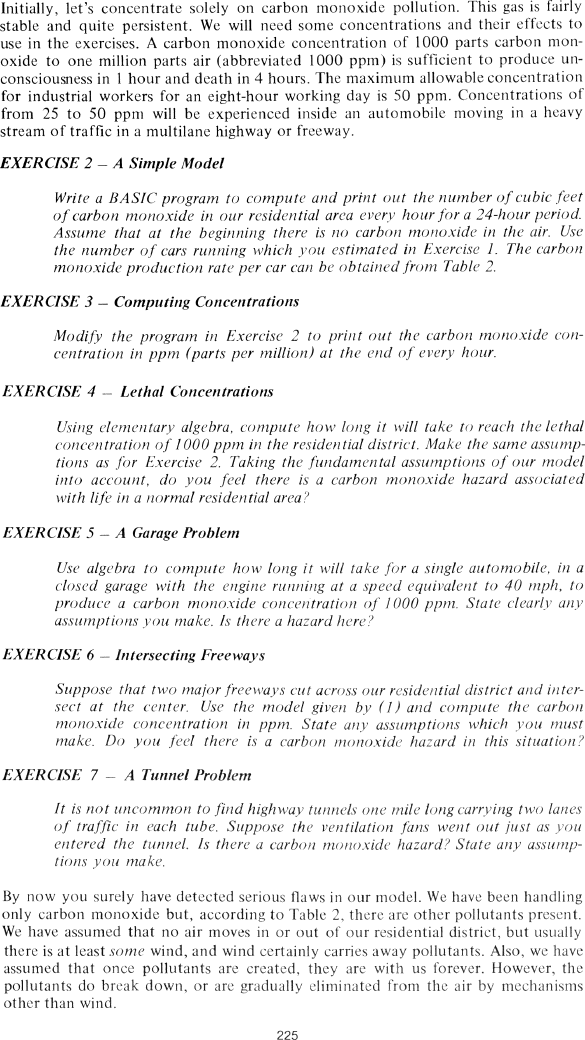The Best of Creative Computing Volume 1 (published 1976)
The Automobile and Air Pollution (carbon monoxide concentrations, garage problem, intersecting freeways, tunnel problem)

Initially, let's concentrate solely on carbon monoxide pollution. This gas is
fairly stable and quite persistent. We will need some concentrations and their
effects to use in the exercises. A carbon monoxide concentration of 1000 parts
carbon monoxide to one million parts air (abbreviated l000 ppm) is sufficient to
produce unconsciousness in l hour and death in 4 hours. The maximum allowable
concentration for industrial workers for an eight-hour working day is 50 ppm.
Concentrations of from 25 to 50 ppm will be experienced inside an automobile
moving in a heavy stream of traffic in a multilane highway or freeway.
EXERCISE 2 - A Simple Model
Write a BASIC program to compute and print out the number of cubic feet of
carbon monoxide in our residential area every hour for a 24-hour period. Assume
that at the beginning there is no carbon monoxide in the air. Use the number of
cars running which you estimated in Exercise 1. The carbon monoxide production
rate per car can be obtained from Table 2.
EXERCISE 3 - Computing Concentrations
Modify the program in Exercise 2 to print out the carbon monoxide concentration
in ppm (parts per million) at the end of every hour.
EXERCISE 4 - Lethal Concentrations
Using elementary algebra, compute how long it will take to reach the lethal
concentration of 1000 ppm in the residential district. Make the same assumptions
as for Exercise 2. Taking the fundamental assumptions of our model into account,
do you feel there is a carbon monoxide hazard associated with life in a normal
residential area?
EXERCISE 5 - A Garage Problem
Use algebra to compute how long it will take for a single automobile, in a
closed garage with the engine running at a speed equivalent to 40 mph, to
produce a carbon monoxide concentration of 1000 ppm. State clearly any
assumptions you make. Is there a hazard here?
EXERCISE 6 - Intersecting Freeways
Suppose that two major freeways cut across our residential district and
intersect at the center. Use the model given by (1) and compute the carbon
monoxide concentration in ppm. State any assumptions which you must
make. Do you feel there is a carbon monoxide hazard in this situation?
EXERCISE 7 - A Tunnel Problem
It is not uncommon to find highway tunnels one mile long carrying two lanes of
traffic in each tube. Suppose the ventilation fans went out just as you entered
the tunnel. Is there a carbon monoxide hazard? State any assumptions you make.
By now you surely have detected serious flaws in our model. We have been
handling only carbon monoxide but, according to Table 2, there are other
pollutants present. We have assumed that no air moves in or out of our
residential district, but usually there is at least some wind, and wind
certainly carries away pollutants. Also, we have assumed that once pollutants
are created, they are with us forever. However, the pollutants do break down, or
are gradually eliminated from the air by mechanisms other than wind.
225


